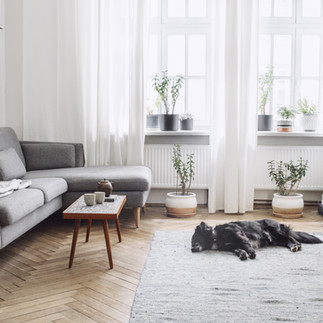Before you begin your home renovation project, there are a few things to think about when working with an interior designer. One of the most important aspects is budget. How much do you want to spend and is your budget realistic? The following tips are key, especially if you've never used a designer before.
Have your wish list ready - your interior designer will let you know what is feasible and what may need a larger budget. Be clear about your scope of works - what do you want them to do?
If you are unsure what things cost, think about an amount you are comfortable spending and talk it over with the professional.
Think carefully about materials: do you want natural materials (wood, cotton, wool, leather)? Natural products will have flaws (cows get stung and bitten too) and will not be perfect, so choose natural materials if you want an imperfect look or a 'lived in' look. Natural materials does not necessarily mean they will be cheaper. They are not mass produced and can take a little longer.
If you change your mind, expect your new choices may be more expensive. If however, you want items to be cheaper, be honest with your designer about your expectations. Also, be realistic about your expectations.
Allow an amount for accessories. A room without them can look and feel cold, so a few hundred pounds on cushions, throws, rugs and artwork can make all the difference to the finished product.
Think carefully about paint choices, premium paints can cost a lot more for a similar outcome. If you're on a budget, ask your designer about trade finishes. These can be 50% less in some cases and would anyone know the difference?
If you change dates, be aware your designer may not be able to get the contractors they originally priced for. If furniture is ordered, this may have to be stored. There will be costs associated with this.
Make sure you understand the design, finishes and timescales. Mis communication is one of the most common reasons why projects don't go as planned. Projects that don't go as planned, cost more. Don't assume anything.
Be careful of giving orders to contractors without agreement with your designer. The contractor may be trying to be helpful and may not mention there will be an extra cost but may levy an additional charge on your designer, who will then need to pass it onto you.
If you are planning a kitchen, materials are key. Your worktop choice could double the cost and cupboard internals is another area where costs can spiral. If some materials are key, are you prepared to compromise on anything else to stay within your budget.
Make sure you understand labour costs can be very regional. Sometimes you can't use existing contractors in another area for the same client due to travel distances, material costs and most importantly, time.
If you keep changing your mind, your project will cost you more. The more re-designs a designer has to do, the more time it will take. Usually a designer will allow for around 3 design changes while fine tuning the design for your space. Any additional changes may mean an hourly rate (as the designer may not be able to quantify the time required), which can quickly add up to a large sum.
Ultimately, you are enlisting a professional to help you create your space. Do listen to their advice. A good designer will always remember, it's your home. If communication is good, so should the journey so enjoy the journey, enjoy your new space!






Comments